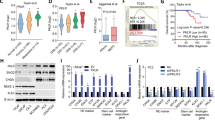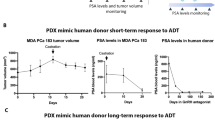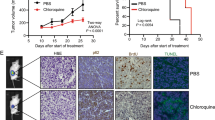Abstract
Specific metabolic underpinnings of androgen receptor (AR)-driven growth in prostate adenocarcinoma (PCa) are largely undefined, hindering the development of strategies to leverage the metabolic dependencies of this disease when hormonal manipulations fail. Here we show that the mitochondrial pyruvate carrier (MPC), a critical metabolic conduit linking cytosolic and mitochondrial metabolism, is transcriptionally regulated by AR. Experimental MPC inhibition restricts proliferation and metabolic outputs of the citric acid cycle (TCA) including lipogenesis and oxidative phosphorylation in AR-driven PCa models. Mechanistically, metabolic disruption resulting from MPC inhibition activates the eIF2α/ATF4 integrated stress response (ISR). ISR signalling prevents cell cycle progression while coordinating salvage efforts, chiefly enhancing glutamine assimilation into the TCA, to regain metabolic homeostasis. We confirm that MPC function is operant in PCa tumours in vivo using isotopomeric metabolic flux analysis. In turn, we apply a clinically viable small molecule targeting the MPC, MSDC0160, to pre-clinical PCa models and find that MPC inhibition suppresses tumour growth in hormone-responsive and castrate-resistant conditions. Collectively, our findings characterize the MPC as a tractable therapeutic target in AR-driven prostate tumours.
This is a preview of subscription content, access via your institution
Access options
Access Nature and 54 other Nature Portfolio journals
Get Nature+, our best-value online-access subscription
$29.99 / 30 days
cancel any time
Subscribe to this journal
Receive 12 digital issues and online access to articles
$119.00 per year
only $9.92 per issue
Buy this article
- Purchase on Springer Link
- Instant access to full article PDF
Prices may be subject to local taxes which are calculated during checkout






Similar content being viewed by others
Data availability
Analyzed RPPA data are available in Supplementary Data 2, analyzed RNA-sequencing data are available in Supplementary Data 3 and raw RNA-sequencing data are available under accession number GSE114708 on the National Center for Biotechnology Information Gene Expression Omnibus database. All other data described, analyzed and represented in the figures present in this study are available from the corresponding authors upon reasonable request.
References
Pavlova, N. N. & Thompson, C. B. The emerging hallmarks of cancer metabolism. Cell. Metab. 23, 27–47 (2016).
DeBerardinis, R. J. & Chandel, N. S. Fundamentals of cancer metabolism. Sci. Adv. 2, e1600200 (2016).
Keibler, M. A. et al. Metabolic requirements for cancer cell proliferation. Cancer Metab. 4, 16 (2016).
Vander Heiden, M. G. & DeBerardinis, R. J. Understanding the intersections between metabolism and cancer biology. Cell 168, 657–669 (2017).
Wang, Q. et al. Androgen receptor and nutrient signaling pathways coordinate the demand for increased amino acid transport during prostate cancer progression. Cancer Res. 71, 7525–7536 (2011).
Deblois, G. & Giguère, V. Oestrogen-related receptors in breast cancer: control of cellular metabolism and beyond. Nat. Rev. Cancer 13, 27–36 (2013).
Massie, C. E. et al. The androgen receptor fuels prostate cancer by regulating central metabolism and biosynthesis. EMBO J. 30, 2719–2733 (2011).
Mohler, J. L. et al. Prostate cancer, version 1.2016. J. Natl Compr. Canc. Netw. 14, 19–30 (2016).
Mitsiades, N. A road map to comprehensive androgen receptor axis targeting for castration-resistant prostate cancer. Cancer Res. 73, 4599–4605 (2013).
Scher, H. I. & Sawyers, C. L. Biology of progressive, castration-resistant prostate cancer: directed therapies targeting the androgen-receptor signaling axis. J. Clin. Oncol. 23, 8253–8261 (2005).
Herzig, S. et al. Identification and functional expression of the mitochondrial pyruvate carrier. Science 337, 93–96 (2012).
Bricker, D. K. et al. A mitochondrial pyruvate carrier required for pyruvate uptake in yeast, drosophila, and humans. Science 337, 96–100 (2012).
Schell, J. C. et al. A role for the mitochondrial pyruvate carrier as a repressor of the warburg effect and colon cancer cell growth. Mol. Cell 56, 400–413 (2014).
Costello, L. C. & Franklin, R. B. The clinical relevance of the metabolism of prostate cancer; zinc and tumor suppression: connecting the dots. Mol. Cancer 5, 17 (2006).
Zadra, G., Photopoulos, C. & Loda, M. The fat side of prostate cancer. Biochim. Biophys. Acta 1831, 1518–1532 (2013).
Cancer Genome Atlas Research Network. The Molecular Taxonomy of Primary Prostate Cancer. Cell 163, 1011–1025 (2015).
Cerami, E. et al. The cBio cancer genomics portal: an open platform for exploring multidimensional cancer genomics data. Cancer Discov. 2, 401–404 (2012).
Beltran, H. et al. Divergent clonal evolution of castration-resistant neuroendocrine prostate cancer. Nat. Med. 22, 298–305 (2016).
Barretina, J. et al. The Cancer Cell Line Encyclopedia enables predictive modelling of anticancer drug sensitivity. Nature 483, 603–607 (2012).
Chattopadhyay, I. et al. Src promotes castration-recurrent prostate cancer through androgen receptor-dependent canonical and non-canonical transcriptional signatures. Oncotarget 8, 10324–10347 (2017).
Hu, R. et al. Ligand-independent androgen receptor variants derived from splicing of cryptic exons signify hormone-refractory prostate cancer. Cancer Res. 69, 16–22 (2009).
Culig, Z. et al. Switch from antagonist to agonist of the androgen receptor bicalutamide is associated with prostate tumour progression in a new model system. Br. J. Cancer 81, 242–251 (1999).
Panigrahi, A. K. et al. SRC-3 coactivator governs dynamic estrogen-induced chromatin looping interactions during transcription. Mol. Cell 70, 679–694.e7 (2018).
Pomerantz, M. M. et al. The androgen receptor cistrome is extensively reprogrammed in human prostate tumorigenesis. Nat. Genet. 47, 1346–1351 (2015).
Stelloo, S. et al. Androgen receptor profiling predicts prostate cancer outcome. EMBO Mol. Med. 7, 1450–1464 (2015).
Sullivan, L. B., Gui, D. Y. & Vander Heiden, M. G. Altered metabolite levels in cancer: implications for tumour biology and cancer therapy. Nat. Rev. Cancer 16, 680–693 (2016).
Halestrap, A. P. The mitochondrial pyruvate carrier. Kinetics and specificity for substrates and inhibitors. Biochem. J. 148, 85–96 (1975).
Anantharaman, A. & Friedlander, T. W. Targeting the androgen receptor in metastatic castrate-resistant prostate cancer: a review. Urol. Oncol. Semin. Orig. Investig. 34, 356–367 (2016).
Hildyard, J. C. W., Ammälä, C., Dukes, I. D., Thomson, S. A. & Halestrap, A. P. Identification and characterisation of a new class of highly specific and potent inhibitors of the mitochondrial pyruvate carrier. Biochim. Biophys. Acta 1707, 221–230 (2005).
Halestrap, A. P. The monocarboxylate transporter family—structure and functional characterization. IUBMB Life 64, 1–9 (2012).
Polański, R. et al. Activity of the monocarboxylate transporter 1 inhibitor AZD3965 in small cell lung cancer. Clin. Cancer Res. 20, 926–937 (2014).
Davidson, S. M. et al. Environment impacts the metabolic dependencies of ras-driven non-small cell lung cancer. Cell. Metab. 23, 517–528 (2016).
Subramanian, A. et al. Gene set enrichment analysis: a knowledge-based approach for interpreting genome-wide expression profiles. Proc. Natl Acad. Sci. USA 102, 15545–15550 (2005).
Pakos-Zebrucka, K. et al. The integrated stress response. EMBO Rep. 17, 1374–1395 (2016).
Hamanaka, R. B., Bennett, B. S., Cullinan, S. B. & Diehl, J. A. PERK and GCN2 contribute to eIF2α phosphorylation and cell cycle arrest after activation of the unfolded protein response pathway. Mol. Biol. Cell 16, 5493–5501 (2005).
Yang, C. et al. Glutamine oxidation maintains the TCA cycle and cell survival during impaired mitochondrial pyruvate transport. Mol. Cell 56, 414–424 (2014).
Faubert, B. et al. Lactate metabolism in human lung tumors. Cell 171, 358–371.e9 (2017).
Hui, S. et al. Glucose feeds the TCA cycle via circulating lactate. Nature 551, 115–118 (2017).
Herbst, E. A. F., George, M. A. J., Brebner, K., Holloway, G. P. & Kane, D. A. Lactate is oxidized outside of the mitochondrial matrix in rodent brain. Appl. Physiol. Nutr. Metab. 43, 467–474 (2017).
Chen, Y. J. et al. Lactate metabolism is associated with mammalian mitochondria. Nat. Chem. Biol. 12, 937–943 (2016).
Corbet, C. et al. Interruption of lactate uptake by inhibiting mitochondrial pyruvate transport unravels direct antitumor and radiosensitizing effects. Nat. Commun. 9, 1208 (2018).
Liu, I. J., Zafar, M. B., Lai, Y.-H., Segall, G. M. & Terris, M. K. Fluorodeoxyglucose positron emission tomography studies in diagnosis and staging of clinically organ-confined prostate cancer. Urology 57, 108–111 (2001).
Nelson, S. J. et al. Metabolic imaging of patients with prostate cancer using hyperpolarized [1-13C]pyruvate. Sci. Transl. Med. 5, 198ra108 (2013).
Shah, R. et al. An evaluation of MSDC-0160, a prototype mTOT modulating insulin sensitizer, in patients with mild Alzheimer’s disease. Curr. Alzheimer Res. 11, 564–573 (2014).
Colca, J. R. et al. Clinical proof-of-concept study with MSDC-0160, a prototype mTOT-modulating insulin sensitizer. Clin. Pharmacol. Ther. 93, 352–359 (2013).
Ghosh, A. et al. Mitochondrial pyruvate carrier regulates autophagy, inflammation, and neurodegeneration in experimental models of Parkinsons disease. Sci. Transl. Med. 8, 368ra174 (2016).
Kolenko, V., Teper, E., Kutikov, A. & Uzzo, R. Zinc and zinc transporters in prostate carcinogenesis. Nat. Rev. Urol. 10, 219–226 (2013).
Schell, J. C. et al. Control of intestinal stem cell function and proliferation by mitochondrial pyruvate metabolism. Nat. Cell Biol. 19, 1027–1036 (2017).
Schulte, M. L. et al. Pharmacological blockade of ASCT2-dependent glutamine transport leads to antitumor efficacy in preclinical models. Nat. Med. 24, 194–202 (2018).
McCommis, K. S. et al. Targeting the mitochondrial pyruvate carrier attenuates fibrosis in a mouse model of nonalcoholic steatohepatitis. Hepatology 65, 1543–1556 (2017).
Divakaruni, A. S. et al. Inhibition of the mitochondrial pyruvate carrier protects from excitotoxic neuronal death. J. Cell. Biol. 216, 1091–1105 (2017).
Rauckhorst, A. J. et al. The mitochondrial pyruvate carrier mediates high fat diet-induced increases in hepatic TCA cycle capacity. Mol. Metab. 6, 1468–1479 (2017).
Nancolas, B. et al. The anti-tumour agent lonidamine is a potent inhibitor of the mitochondrial pyruvate carrier and plasma membrane monocarboxylate transporters. Biochem. J. 473, 929–936 (2016).
Divakaruni, A. S. et al. Thiazolidinediones are acute, specific inhibitors of the mitochondrial pyruvate carrier. Proc. Natl. Acad. Sci. USA 110, 5422–5427 (2013).
Lyles, B. E., Akinyeke, T. O., Moss, P. E. & Stewart, L. V. Thiazolidinediones regulate expression of cell cycle proteins in human prostate cancer cells via PPARγ-dependent and PPARγ-independent pathways. Cell Cycle 8, 268–277 (2009).
Fröhlich, E. & Wahl, R. Chemotherapy and chemoprevention by thiazolidinediones. Biomed Res. Int. 2015, 845340 (2015).
Suzuki, S. et al. Pioglitazone, a peroxisome proliferator-activated receptor γ agonist, suppresses rat prostate carcinogenesis. Int. J. Mol. Sci. 17, 2071 (2016).
Hensley, C. T. T. et al. Metabolic heterogeneity in human lung tumors. Cell 164, 681–694 (2016).
Taylor, B. S. et al. Integrative genomic profiling of human prostate cancer. Cancer Cell. 18, 11–22 (2010).
Morris, J. K. A formaldehyde glutaraldehyde fixative of high osmolality for use in electron microscopy. J. Cell. Biol. 27, 1A–149A (1965).
Darzynkiewicz, Z. & Juan, G. DNA content measurement for DNA ploidy and cell cycle analysis. Curr. Protoc. Cytom. 00, 7.5.1–7.5.24 (2001).
Bae, S., Park, J. & Kim, J. S. Cas-OFFinder: a fast and versatile algorithm that searches for potential off-target sites of Cas9 RNA-guided endonucleases. Bioinformatics 30, 1473–1475 (2014).
Putluri, N. et al. Metabolomic profiling reveals a role for androgen in activating amino acid metabolism and methylation in prostate cancer cells. PLoS ONE 6, e21417 (2011).
Kettner, N. M. et al. Circadian homeostasis of liver metabolism suppresses hepatocarcinogenesis article circadian homeostasis of liver metabolism suppresses hepatocarcinogenesis. Cancer Cell 30, 909–924 (2016).
Ramirez, M. S. et al. Radial spectroscopic MRI of hyperpolarized [1-13C] pyruvate at 7 tesla. Magn. Reson. Med. 72, 986–995 (2014).
Bankson, J. A. et al. Kinetic modeling and constrained reconstruction of hyperpolarized [1-13C]-pyruvate offers improved metabolic imaging of tumors. Cancer Res. 75, 4708–4717 (2015).
Acknowledgements
This study was supported by grants from the US National Institutes of Health (NIH): grant no. R21CA205257 (S.E.M.), F30CA196108 (D.A.B.), K01DK096093, R03DK105006, R01DK114356 (S.M.H.), R01CA211150 (J.A.B.), R01CA220297 (N.P.), F30AG050412 (H.M.-S.), U01CA167234 (A.S.), PO1DK113954 and HD08818 (B.W.O.), the Prostate Cancer Foundation (S.E.M.), The Caroline Weiss Law Scholar Foundation (S.E.M.), The MD Anderson Physician Scientist Development Program (S.E.M.), and the Cancer Research and Prevention Institute of Texas (RP140021-P5 (J.A.B.) and RP140106 (MDACC)). D.A.B. is a C. Thomas Caskey Scholar. D.A.B., H.M.-S. and M.P.H. are supported by the Baylor College of Medicine (BCM) Medical Scientist Training Program. S.M.H. is supported by the BCM Bridge to Independence Program and the Alkek Center for Molecular Discovery. M.P.H. is supported by the B.R.A.S.S. program, and the Robert and Janice McNair Foundation. V.P., N.P., A.S., K.R. and C.C. are supported by the CPRIT Core Facility Support Award RP120092, the NCI Cancer Center Support Grant P30CA125123, intramural funds from the Dan L. Duncan Cancer Center, and Alkek Center for Molecular Discovery. Additional support is from the American Cancer Society (127430-RSG-15-105-01-CNE to N.P.), CPRIT (RP150451 to A.S.) and GE Healthcare (J.A.B and C.W). The BCM Metabolomics Core is a designated Agilent Technologies Center for Excellence in Mass Spectrometry. We thank the following BCM Cores: Human Tissue Acquisition and Pathology (NCI-CA125123), Mouse Metabolism (director P. Saha), Integrated Microscopy (NCI-CA125123, NIDDK-56338-13/15, CPRIT RP150578, and the John S. Dunn Gulf Coast Consortium for Chemical Genomics), Cytometry and Cell Sorting (director J. Sederstrom, NIAID P30AI036211, NCI P30CA125123, and NCRR S10RR024574). We thank the M.D.A.C.C. Characterized Cell Line Core and Small Animal Imaging Facility (P30-CA016672). We thank J. Colca and the Metabolic Solutions Development Company for generously providing MSDC0160. We thank D. Townley for TEM imaging and B. Krishnan, M. Finegold, and G. Stoica for reviewing TEM images. We thank J. Rutter, D. Moore and A. Means for insightful conversations related to this manuscript. We acknowledge the joint participation by the Diana Helis Henry Medical Research Foundation through its direct engagement in the continuous active conduct of medical research (S.E.M. and A.S.).
Author information
Authors and Affiliations
Contributions
D.A.B. and S.E.M. conceptualized the study. D.A.B., S.M.H. and S.E.M. designed experiments. D.A.B. wrote the manuscript with editorial input from all authors. D.A.B. performed all experiments with assistance as noted: S.M.H. assisted with immunofluorescence. A.S., V.P. and N.P. assisted with mass spectroscopy measurements. L.Z., C.F., E.A.S. and H.M.-S. assisted with animal tumour growth experiments. P.K.S. performed U13C glucose infusions. B.W.O. and A.P. provided reagents and performed in vitro transcription experiments. J.A.B. and C.W. performed hyperpolarized pyruvate imaging. M.P.H., C.C. and K.R. assisted with clinical dataset analysis. R.C. performed RNA sequencing. K.R. and C.C. assisted with RPPA data analysis, RNA sequencing data analysis, and AR ChIP sequencing integrative analysis. M.M.I. provided clinical specimens. N.M. provided prostate cancer models. All work was performed under the supervision of S.E.M.
Corresponding authors
Ethics declarations
Competing Interests
The authors declare no competing interests.
Additional information
Publisher’s note: Springer Nature remains neutral with regard to jurisdictional claims in published maps and institutional affiliations.
Supplementary information
Supplementary Text and Figures
Supplementary Figures 1–7
Supplementary Data 1
Informatic nomination and candidate genes
Supplementary Data 2
Reverse phase protein array (RPPA) data from ABL cells treated with UK5099
Supplementary Data 3
Analyzed RNA-sequencing data from ABL cells treated with UK5099
Supplementary Data 4
Reagent-related materials including antibodies, primers, sgRNA sequences, STR authentication data, and mycoplasma screening data
Rights and permissions
About this article
Cite this article
Bader, D.A., Hartig, S.M., Putluri, V. et al. Mitochondrial pyruvate import is a metabolic vulnerability in androgen receptor-driven prostate cancer. Nat Metab 1, 70–85 (2019). https://doi.org/10.1038/s42255-018-0002-y
Received:
Accepted:
Published:
Issue Date:
DOI: https://doi.org/10.1038/s42255-018-0002-y
Keywords
This article is cited by
-
Transcending frontiers in prostate cancer: the role of oncometabolites on epigenetic regulation, CSCs, and tumor microenvironment to identify new therapeutic strategies
Cell Communication and Signaling (2024)
-
Metabolism-based targeting of MYC via MPC-SOD2 axis-mediated oxidation promotes cellular differentiation in group 3 medulloblastoma
Nature Communications (2023)
-
Pyruvate anaplerosis is a targetable vulnerability in persistent leukaemic stem cells
Nature Communications (2023)
-
Flavinated SDHA underlies the change in intrinsic optical properties of oral cancers
Communications Biology (2023)
-
Preclinical models of prostate cancer — modelling androgen dependency and castration resistance in vitro, ex vivo and in vivo
Nature Reviews Urology (2023)



